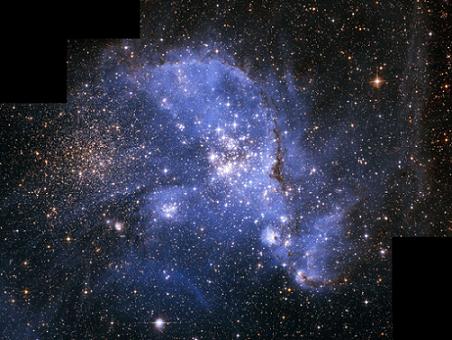Among the stars in the Small Magellanic Cloud are also star clusters as well as the nebula NGC 346 which is a star forming region 200 light years wide
Avi Blizovsky

The Small Magellanic Cloud is a satellite galaxy of the Milky Way, and is considered one of the wonders of the southern sky. It lies 210 thousand light years away in the direction of the Tucana constellation.
Among the stars in the Small Magellanic Cloud are also star clusters as well as the nebula NGC 346 which is a star forming region 200 light years wide.
The image was taken by the Hubble Space Telescope. The astronomers identified a chain population of embryonic stars along the dark region. Dust bands are clearly visible in the right part of the image. Still collapsing within their clouds, the light from the star embryos is redshifted by the interference caused by the dust.
Small galaxies such as the Small Magellanic Cloud and the nursery stars within them are considered the building blocks for today's large galaxies, because it is similar to the galaxies that filled the early universe en masse.
The sharp sharpness of the Hubble Space Telescope was able to reveal a population of embryonic stars that are still forming in NGC 346 as a result of the gravitational collapse of gas clouds. They still haven't ignited their hydrogen fuel to start nuclear fusion. The smallest of these transiting stars had only about half the mass of the Sun.
Although star birth is common in our galaxy's disc, the smaller companion galaxy is more primitive in that it lacks a significant percentage of the heavy elements evident in the Milky Way, which has successive generations of active stars.
Broken galaxies like the Small Magellanic Cloud are thought to be the primitive building blocks of a more massive galaxy. Most galaxies of this type are far away from us, when the universe was much younger. Therefore, the Small Magellanic Cloud is a unique nearby laboratory for understanding the way in which the stars were formed in the early universe. The NGC 346 nebula, located in the small galaxy among many star-forming regions, alone contains 2,500 star embryos.
Hubble's image, taken by the advanced scanning camera, identified three star populations in the galaxy itself and in the NGC 346 nebula, and a total of 70 stars. The oldest population is of stars 4.5 billion years old, roughly the age of the Sun. The young ones are 5 million years old (around the time when the first hominids started walking upright). Lower mass stars require more fuel to ignite and transform into normal stars, so the protostar population is 5 million years old.
Intriguingly, the interstellar population stretches along two intersecting lines within the nebula reminiscent of the letter T in the Hubble photograph.
For information on the NASA website
